The Travelin’ Man goes to Shawnee, Oklahoma: Part two
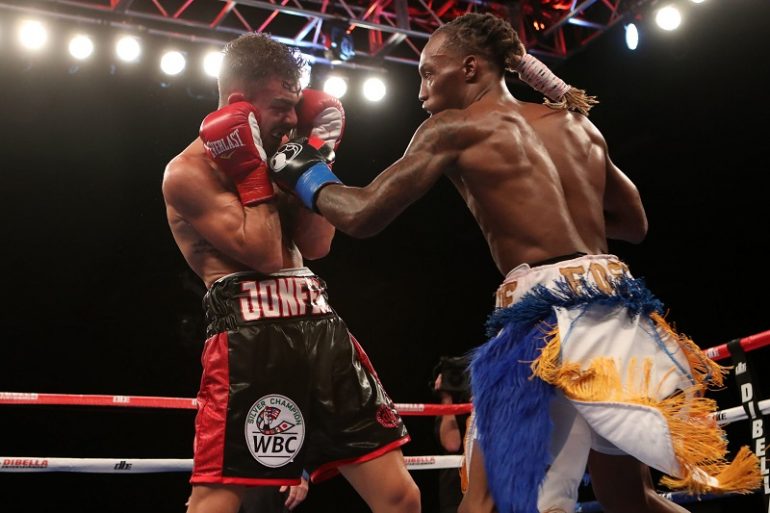
Please click here to read Part One.
Friday, September 21 (continued): Every so often, a fighter produces a performance that proves history can repeat itself. Such was the case with junior lightweight O’Shaquie Foster, who, as an underdog, used superb two-way mobility, timely counters, high-end intelligence and outstanding resourcefulness to earn a stunning 10-round unanimous decision over long, lean power-hitter Jon Fernandez, who entered the bout on a 12-fight knockout streak. The most amazing aspect of Foster’s performance was that he achieved this result while operating inside a ring measuring just 16 feet, two inches. How do I know this? Earlier in the afternoon, senior production manager Joie Silva measured the startlingly small ring (which, to me, looked around 14 feet square) and called out the result when I queried from ringside.
During the late stages of Foster’s performance, my mind instantly flashed back to July 26, 1978, at Madison Square Garden, the site of that decade’s most shocking upsets. Reigning WBC junior lightweight champion Alexis Arguello, a long lean power-hitter who had stopped 12 of his last 13 opponents to push his record to 56-4 (with 47 knockouts), met the shorter but far quicker Vilomar Fernandez, a 22-6-2 (with 7 KOs) fighter good enough to take a prime Roberto Duran into the 13th round, in his lone championship opportunity, but who still was a prohibitive underdog against the nuke-fisted Nicaraguan. Although Arguello had engaged in non-title fights for which he scaled neared the lightweight championship limit, the scuttlebutt around ringside indicated Arguello was using the Fernandez fight to earn a ranking at 135 and justify a mega-fight with “Manos de Piedra,” who wanted to earn one last big payday before moving up in weight.
Unfortunately for Arguello, Duran and boxing history, Fernandez chose that night to perform his best Willie Pep impression. And what an impression it was!
From first bell to last, Fernandez was the quintessence of ring generalship, as his outstanding footwork and array of defensive moves made Arguello look like he was mired in mud, while his willingness to dive in behind lightning-like flurries had the MSG crowd roaring in delight. Yes, Arguello was the star and, on most nights, the crowd favorite thanks to his gentlemanly demeanor, but once Fernandez proved he could compete with the mighty Arguello, the audience shifted its allegiance to Fernandez, a Dominican by birth but a Bronx resident by choice. Fernandez’s sustained success frustrated Arguello to the point in which he faked a bolo punch that earned boos and, in the ninth, stood in front of Fernandez with his left arm dangling.
When all was said and done, Fernandez captured a majority decision that could have been unanimous, given his statistical dominance (142-112 overall, 21-13 jabs, 121-99 power and percentage gaps of 40%-20% overall, 20%-5% jabs and 48%-32% power). The round-by-round breakdown had Fernandez up 8-2 in total connects, 6-2-2 in landed jabs and 7-3 in power shots. Arguello’s loss, combined with Duran’s closing window at 135, conspired to kill the dream match for all time. (Note: For a more detailed account of this fight, please purchase a copy of “Tales From the Vault: A Celebration of 100 Boxing Closet Classics, which is available on Amazon. For those whom already have a copy, it starts on page 604. I hope you’ll enjoy reading it as much as I enjoyed writing it.)
The stakes weren’t nearly as high for Foster and Fernandez, in a macro sense, but, in terms of their individual careers, it was a vital crossroads fight in which victory meant a significant step up the ladder, in terms of future competition and, hopefully, compensation.
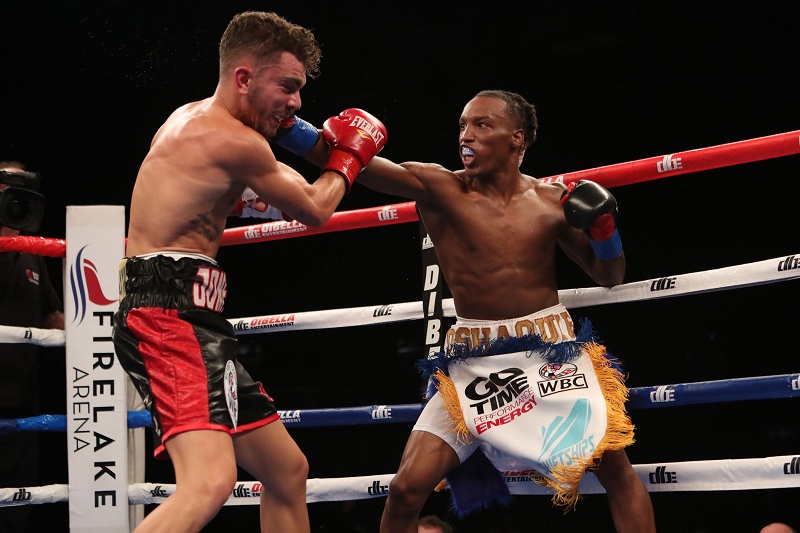
Junior lightweight O’Shaquie Foster (right) vs. Jon Fernandez. Photo credit: Dave Mandel/Showtime
The statistics favoring Foster were illuminating. Not only did he out-land Fernandez in every phase (145-102 overall, 49-13 jabs, 96-89 power), he connected far more accurately (36%-17% overall, 30%-5% jabs, 39%-25% power) and limited the Spaniard to single-digit connects in six of the 10 rounds, including each of the first five. Here are several other measures of how well Foster’s Vilomar-like tactics blunted the Arguello-like pursuit of Jon Fernandez:
* In his six previous CompuBox-tracked fights, Fernandez averaged 103.2 punches per round, far above the 57.5 junior lightweight average. Against Foster, Fernandez averaged 61.9, including just 49.8 through the first four.
* Fernandez averaged 8.4 landed jabs per round in his six other tracked fights but against Foster, he landed just 13 jabs in the entire 10-round fight.
* Fernandez had averaged 24.1 power connects per round against his six previous foes. That figure plummeted to 8.9 against Foster.
* Fernandez landed 43.6% of his power punches versus his other opponents. Against Foster, he connected on his 24.7% of his hooks, crosses and uppercuts for the fight and in the first five rounds, he landed 8%, 11%, 5%, 18% and 15%.
Foster, for his part, not only lived up to his profile, he improved on it. For example, Foster landed 38.1% of his power punches against his four previous CompuBox-tracked opponents and, against Fernandez, he connected on 39.2%. Also he achieved a personal belt in round two by landing 11 jabs and by connecting on 49 jabs in the fight. He also landed more total punches on Fernandez than any previous CompuBox-tracked opponent, with his 145 more than doubling the 70 connects recorded by Garza.
The round-by-round breakdown justified the lopsided scorecards, as Foster led 8-2 in total connects, 10-0 in landed jabs and 6-3-1 in power connects.
“I did need this,” Foster said. “I had to show people who I really am and this puts me back in the picture. I had to focus and put all of the bad habits I had behind me, get away from the people and the bad activity, and regain focus to show everybody what I can do. This win will put people on notice. I won’t be overlooked anymore. I didn’t want (Fernandez) to sit down on any punches. I wanted to keep his move and move laterally every time he came close. He couldn’t just punch and the lateral movement kept him off balance.”
Not only did he keep Fernandez off-balance, his victory will serve to re-balance the 130-pound picture. Foster later added he wanted to fight again before the end of the year and I hope I will be at ringside to record it.
*
The opening bout of the telecast matched Staten Island’s James Wilkins and Colorado’s Misael Lopez and, around ringside, most agreed that, while Wilkins boasted the much bigger punch and the more prominent star, thanks to his being featured in the documentary “Cradle of Champions,” Lopez, at least during his six-round decision win over Ricky Rodriguez in February 2017, appeared more than capable of winning, thanks to his high-volume attack and his smoother, straighter punches that would contrast with Wilkins’ looping but power-laden blows.
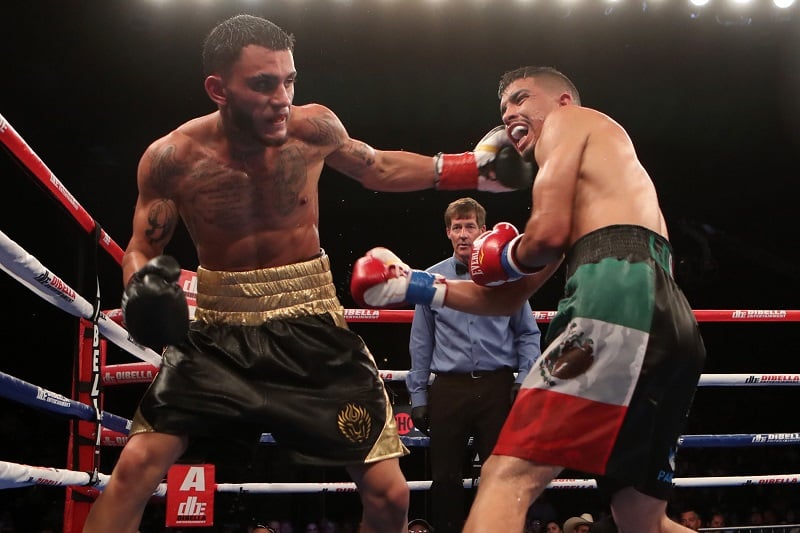
Junior lightweight Misael Lopez (right) vs. James Wilkins. Photo credit: Dave Mandel/Showtime
Like Foster, Lopez out-boxed and out-foxed his more powerful opponent en route to a deserved decision victory. Though an apparent knockdown scored by Wilkins at the end of round seven went uncalled, Lopez’s superior volume (98.8 punches per round to Wilkins’ 66.3), better range control with the jab (20.3 attempts/4.5 connects per round to Wilkins’ 20.4/2.1), more prolific power punching (78.5 attempts and 26.6 connects per round to Wilkins’ 45.9/14.4), better accuracy in all phases (32%-25% overall, 22%-10% jabs, 34%-31% power) and late-round surge (139-68 overall, 116-59 in the final four rounds) led to final leads of 249-132 overall, 36-17 jabs and 213-115 power. The round-by-round breakdown saw Lopez achieve leads of 7-1 overall, 6-1-1 jabs and 7-0-1 power and Wilkins added to his mathematical misery by being docked a point for excessive low blows in round five.
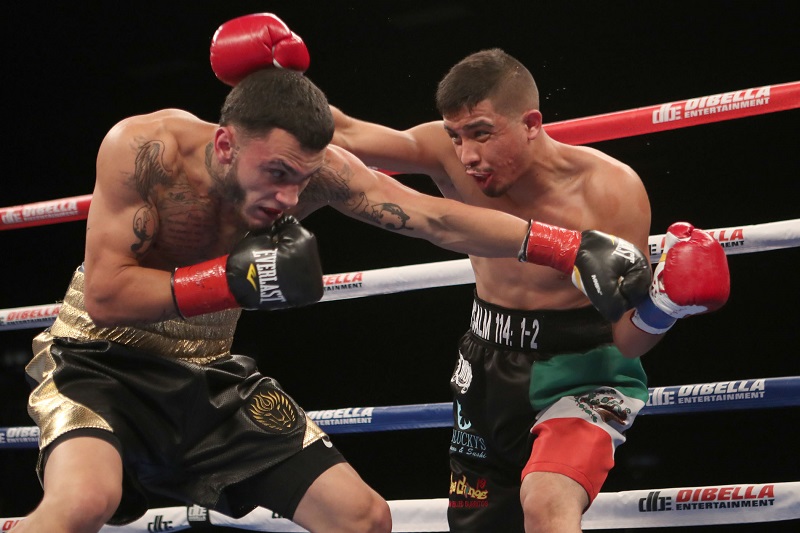
Junior lightweight Misael Lopez (right) vs. James Wilkins. Photo credit: Dave Mandel/Showtime
Showtime analyst Steve Farhood described Wilkins as an angry young man who soon became a frustrated angry young man. The good news for “Crunch Time” is that (1) at age 22, he has time to smooth out the rough edges and become a more measured athlete and (2) he has the gift of one-punch power, which, if harnessed correctly, will still make an impact in his chosen profession. As for Lopez, he is just another example of a fighter who creates excitement without having to produce one-punch pyrotechnics. As a punch-counter, I like recording fighters like Lopez and, although my colleague Andy Kasprzak had the pleasure of tracking him this time, I hope I will get the gig the next time he performs on Showtime.
*
The telecast’s second fight between lightweights Steven Ortiz and Wesley Ferrer didn’t live up to the excitement of the opener but it did provide a formidable challenge for armchair judges, as well as the official panel of Mike Bower (78-74), Henry Ellick (77-75) and Henry Gueary (76-76). The reasons can, in part, be found in this CompuBox stat: In terms of total connects, the fighters were separated by no more than five in any round. (Ortiz led 14-9 in round three.)
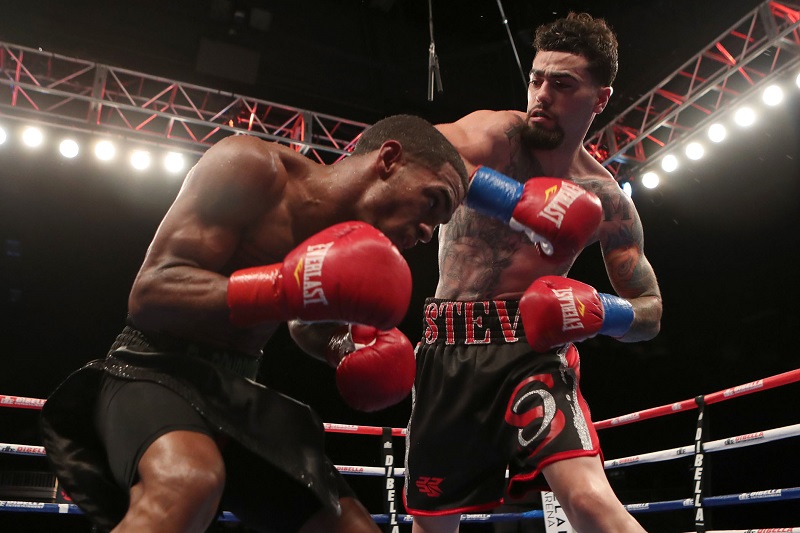
Lightweight Steven Ortiz (right) vs. Wesley Ferrer. Photo credit: Dave Mandel/Showtime
In terms of momentum, Ferrer-Ortiz was a contest that saw Ortiz exploit Ferrer’s tendency to produce slower starts. Following a first round that saw Ortiz build a narrow 13-12 lead in total connects but a larger 60-47 margin in punches thrown, Ortiz built the statistical foundation for his eventual win, thanks to his work in rounds 2-5, in which he out-landed Ferrer 54-41 overall and 41-33 power. Ferrer enjoyed better rounds in the sixth (59 punch attempts and an 18-17 lead in total connects) and the eighth (57 punch attempts and a 22-18 gap in total connects) but Ortiz’s strong seventh (25-22 overall and 71-59 in total punch attempts) served to stall Ferrer’s momentum.
The raw totals favoring Ortiz were small (127-115 overall, 28-22 jabs, 99-93 power as well as a 30%-30% tie overall, a 24%-12% jab accuracy gap by Ortiz, and a 45%-32% power gulf favoring Ferrer) but the above explanation might explain why Ortiz lifted his record to 9-0 (with 3 knockouts)and why Ferrer’s eroded to 12-1-1 (with 7 KOs).
*
The only fighter from the “A-side” corner to emerge victorious on the televised portion was featherweight Irvin Gonzalez, whose sheer industriousness enabled him to score a lopsided eight-round decision over Sergio Martinez protégé Carlos Ramos. A measure of Gonzalez’s ability to deter return fire could be seen in the following stat: In round one, Ramos threw 42 punches and landed 11 but in rounds 2-8, he threw 26, 34, 24, 29, 24, 23 and 23 punches and added just 27 connects to his final total. Meanwhile the long-armed, switch-hitting Gonzalez ranged from 48 punches (round three) to 67 (round two), out-landed Ramos in six of the final seven rounds and prevailed 72-38 overall, 17-10 jabs and 55-28 power. In terms of accuracy, however, Ramos led 17%-16% overall and 11%-8% jabs while tying Gonzalez at 21% power, which indicates that, had he been able to increase his work rate (which was a paltry 28.1 per round compared to Gonzalez’s 58), he would have had a better chance to win. But he didn’t and Gonzalez’s activity and acumen were the reasons.
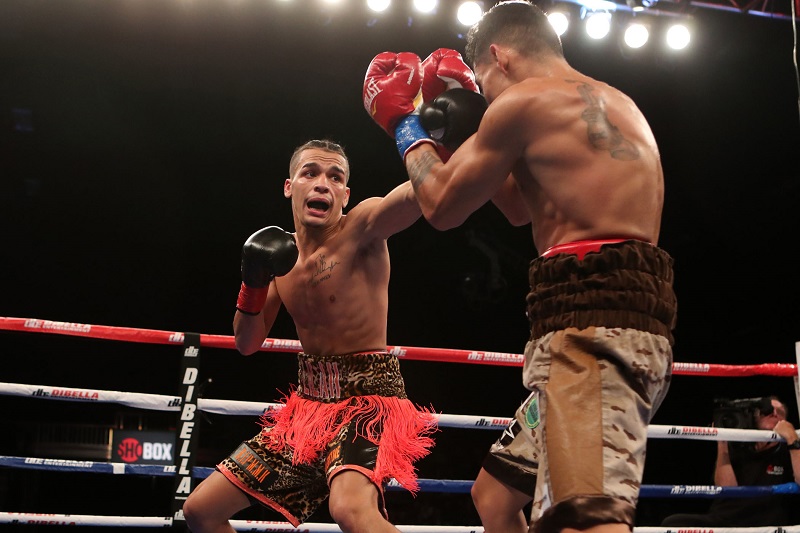
Featherweight Irvin Gonzalez (left) vs. Carlos Ramos. Photo credit: Dave Mandel/Showtime
*
Even as I counted the main event, I already knew tomorrow’s travel day was going to be an adventure. Between rounds one and two, I received a text message from American Airlines that my 2:45 p.m. flight from Dallas Fort-Worth to Pittsburgh was canceled, thanks to extraordinarily heavy rain produced by three systems that mashed into one another. I was assured that the airline was working to place me on an alternative flight and would alert me once that task was completed.
Andy drove us back to the hotel and I spent the next hour inputting the night’s numbers into the master database. With an eye on arising at 8, leaving the hotel at 9 and arriving at Oklahoma City’s airport by 10, I turned out the light at 1:45 a.m.
Saturday, September 22: As is usually the case, I stirred awake about four hours later and decided to doze for another 90 minutes before officially arising. Once I did, I had an idea: Leave for the airport as soon as possible. I figured my early arrival would give American more options, in terms of getting me into Pittsburgh, including routes that don’t involve connecting through Dallas Fort-Worth. Thus I left the hotel a little after 8 a.m.
After filling up the rental’s tank, I arrived at the airport and approached American’s check-in counter. Being a frequent flier, I was able to take my place in what, to this point, had been a non-existent line. However as I arrived, I spotted a group of three who was attempting to redistribute their luggage, so that the biggest bag could get under a certain weight limit. I instantly recognized one of the people as a fighter on last night’s card: Irvin Gonzalez. I congratulated him on his victory, informed him that I was one of the punch counters on the card and told him that I actually counted him.
“Thanks for keeping me busy,” I said, a line which got the hoped-for laugh.
What a nice coincidence: Had I not chosen to depart for the airport an hour earlier than planned, had I not picked that very moment to approach the check-in counter, this little episode wouldn’t have happened. I didn’t know it at the time but more examples of fortuitous circumstance were coming.
Still, my routes to Pittsburgh were severely limited. I certainly wanted to change the flight to which I had been reassigned – which, I learned from the agent in OKC, was a DFW to PIT bird that was scheduled to depart at 8:45 p.m. – but because I was told all of the flights going through Chicago and other locales were full, I had no easy way out. Moments later, the agent found a path that was more acceptable but certainly not perfect: A 1:44 p.m. CDT flight from Oklahoma City to Charlotte, then a 8:26 p.m. flight from Charlotte to Pittsburgh. If all went perfectly, I wouldn’t arrive home until around 1 a.m. but, because some of the options presented to me involved not getting home until the next evening, I asked the agent to book it.
If I were a pessimist, I would have had reason to feel downtrodden; no one likes to spend long hours at the airport, especially if one wants to get home. To me, moping wasn’t going to change the situation or make it any better. One of the most important lessons I’ve learned as “The Travelin’ Man” is this: Although one can’t change the big picture, one can adjust his attitude to achieve the best outcome. In this situation, I saw three reasons to feel positive. First, this situation is built-in material for this travelogue and I’ve been told by readers that they most enjoy the articles in which things go sideways for me. Second, the long hours in Oklahoma City and Charlotte provide the perfect setting for me to get all my writing finished. When things go well, I usually wait until the next day to start writing because I’m too tired once I get home. So, in effect, these delays ultimately would put me ahead of the game. Finally many of today’s airports have plenty of culinary options and other amenities and, with the long wait ahead of me, I can enjoy a leisurely lunch in Oklahoma City and an equally relaxing dinner in Charlotte.
My fortunes began to change a few minutes before boarding the Charlotte flight. As I was talking with a young and attractive businesswoman named Summer, I heard my name called over the loudspeaker. The reason: My ticket was being upgraded to first-class. The reason for that: Earlier in the day I received an email from American Airlines announcing I had achieved Gold member status for the year and one benefit of that designation is being placed higher on the automatic upgrade list.
As I settled into my plush and leg room-friendly seat in row four, I struck up a conversation with the two men on each side. Each was personable and diplomatic and one example of that was when the flight attendant approached us about the choice of meal on the flight. Her dilemma was that she had two garden salads and one wrap remaining and she asked us who wanted what. The three of us settled the issue quickly and with respect (I ended up getting the wrap, which was excellent).
While the man to my right spent the flight watching a movie on his laptop, I ended up conversing with the man across the aisle, who happened to be evangelist Phil Sanders, Ph.D., the host of “In Search of the Lord’s Way,” since taking over for Mack Lyon nearly a decade ago. He too received an upgrade to first-class, which amplifies the degree of fortunate coincidence. While our conversation included matters of faith, the bulk of it centered around sports, including his fandom of anything Oklahoma University.
As the flight neared its conclusion, I noticed the man who was seated two rows up from Dr. Sanders. After the plane touched down and we stood up to collect our luggage from the overhead bins, my eyes scanned down and to my left toward a bag and, inside it, a piece of paper that confirmed my intuition was correct: The man I spotted was none other than golfing legend Chi Chi Rodriguez.
I told the owner of the bag, a younger woman I believed to be his daughter, “As a sports fan, it certainly was an honor to be in the same cabin as Chi Chi Rodriguez. I’d like to say something to him but I don’t want to bother him.”
“Oh, he’s never bothered,” she replied. “He loves signing autographs and taking pictures with everyone.”
So with that knowledge, I approached Rodriguez, shook his hand and expressed my admiration and appreciation for all the sporting memories he created for us fans over the decades. He smiled and said thank you.
I thought about snapping a picture of us together with my cell phone but because we were now inside the terminal I didn’t want to ignite a rush of people by sending the message that I was in the presence of someone famous. I’m sure he wouldn’t have minded but I didn’t want to cause an additional burden to him. Therefore my description here is my only evidence that we actually met.
My next flight was so far into the future that it wasn’t even listed on the master monitor, so I walked toward the nearest American Airlines agent and asked to which gate I needed to go. The answer: C-7.
As I began the long walk toward C-7, I was resigned to the fact that I was going to be in Charlotte for a while. But as I neared the gate, I noticed that the monitor at the gate across from mine also read “Pittsburgh.” That flight, originally set to leave at 4:45 p.m., was delayed until after 6 p.m.
“What if there are seats still open on that flight?” I thought. “What have I got to lose?”
I walked over to that gate but no agent was present. Also waiting there were three passengers whom I later learned were also booked to be on my 8:26 p.m. flight to Pittsburgh and they had the same idea as I did. As the clocked ticked to less than five minutes before the scheduled boarding time, there still was no agent. I looked across the way at C-7 and noticed an agent was there.
“I’ll go over there to see if she knows,” I said. They said OK but didn’t follow me over.
It turned out that 24 seats were open on that flight but, for some reason, she could not get the computer to accept the flight change request. She suggested I go to the customer service area, which happened to be less than 100 steps away.
Yet another excellent twist of fate: No one was in line. The woman who handled my issue ran into the same issues as the agent at C-7 but, being an experienced employee, she found other options to try. Those options took several minutes to complete and while others in my situation would have expressed anger and frustration, I remained calm and cooperative. My demeanor paid dividends, for she ended up placing a call to headquarters instead of giving up on me. It was during that call that the reason for the difficulties was identified: The agent in Oklahoma City – perhaps in her haste to help me – neglected to take the electronic steps necessary to remove my “checked-in” status for my replacement flight at DFW. Therefore electronically speaking, I was in two places at once and, because the DFW flight had been booked first, that took precedence and prevented any additional changes in Charlotte, where, according to the system, I shouldn’t have been. Once the DFW status was removed, I was able to be rebooked to Pittsburgh through Charlotte.
Of course, the time required to figure this out prevented me from making the flight that was minutes away from boarding but it did allow me to get a seat on the next flight, which was now in the midst of the boarding process and would be leaving two hours earlier than my previously assigned flight in Charlotte.
The agent printed two boarding passes to cover me for the next two flights to Pittsburgh. The first flight required a long walk back to Gate B-14 but I made it under the wire: The flight was just eight minutes from closing its doors.
As I stepped inside the cabin, I noticed lots of empty seats. In fact, I had an entire three-seat row to myself. While I didn’t stretch out, it was good to know that I could if I wished to do so.
The plane landed at 7:42 p.m. and I arrived home at 10:44 p.m. – a much better scenario than what was painted at the Oklahoma City check-in counter. I was happy to be home but I know that in just a few days’ time, I will be back on the road. This coming Thursday, I will travel to Temecula, California, to work a ShoBox tripleheader topped by lightweights Juan Carlos Burgos and Devin Haney (who, at age 19, is promoting this card) and supported by super middleweights Cem Kilic and late-sub DeAndre Ware, as well as the rematch between lightweights Zhora Hamazaryan and Thomas Mattice, whose first meeting in July resulted in a hotly-disputed split decision for Mattice.
Until then, happy trails!
*
Lee Groves is a boxing writer and historian based in Friendly, West Virginia. He is a full member of the BWAA, from which he has won 16 writing awards, including two first-place awards, since 2011. He has been an elector for the International Boxing Hall of Fame since 2001 and is also a writer, researcher and punch-counter for CompuBox, Inc. He is the author of “Tales from the Vault: A Celebration of 100 Boxing Closet Classics” (available on Amazon) and the co-author of the newly released book “Muhammad Ali: By the Numbers” (also available on Amazon). To contact Groves about a personalized autographed copy, use the email [email protected] or send him a message via Facebook.
JOIN DAZN AND WATCH SAUNDERS-ANDRADE FOR FREE
Struggling to locate a copy of The Ring Magazine? Try here or
Subscribe
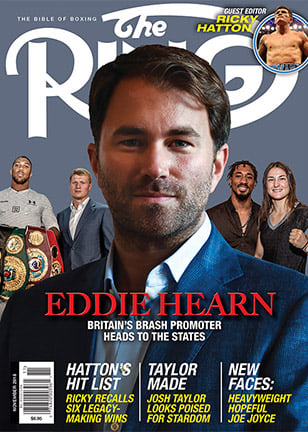
You can order the current issue, which is on newsstands, or back issues from our subscribe page.















